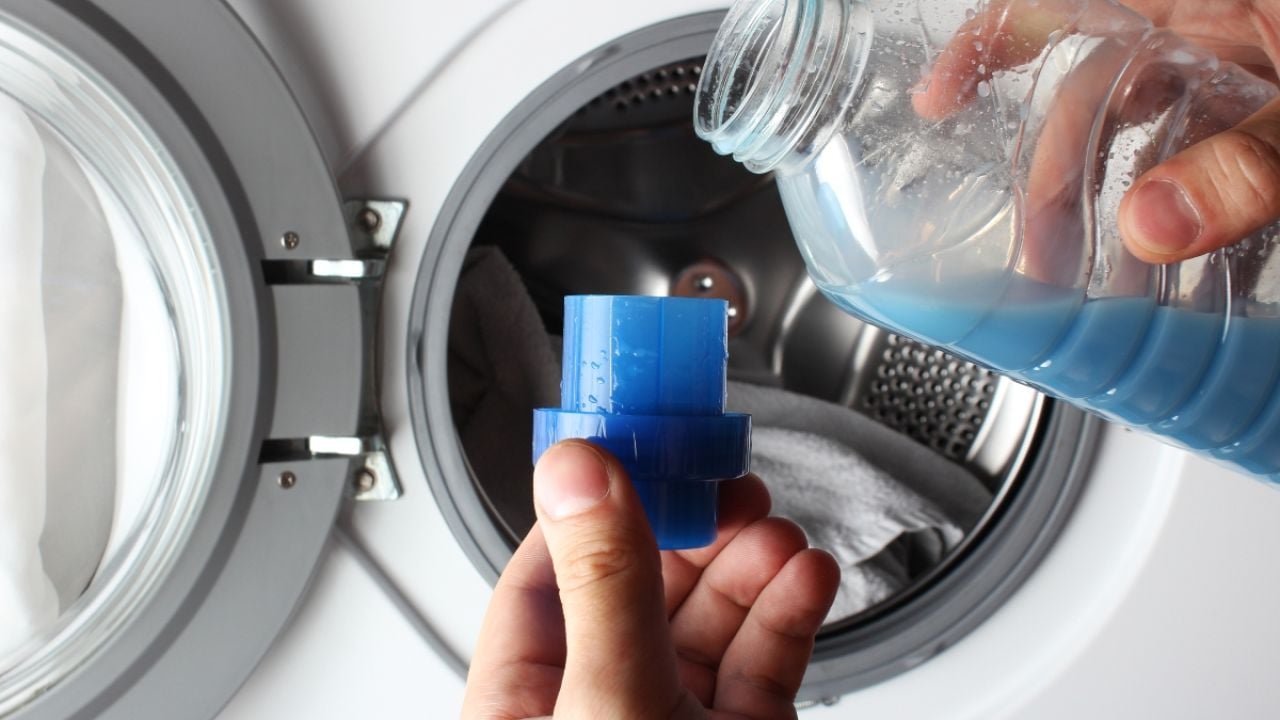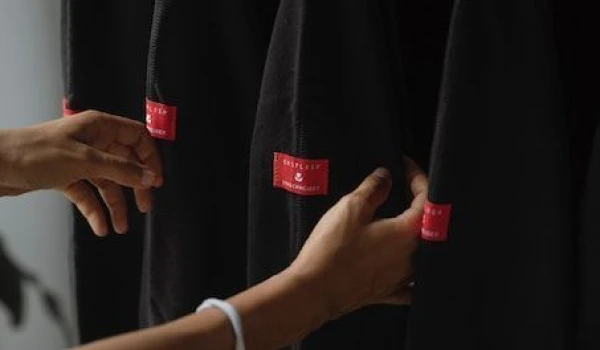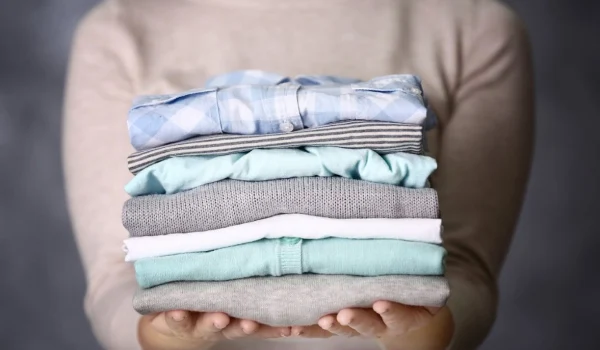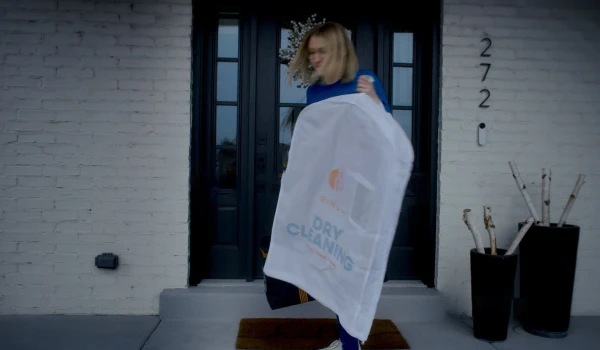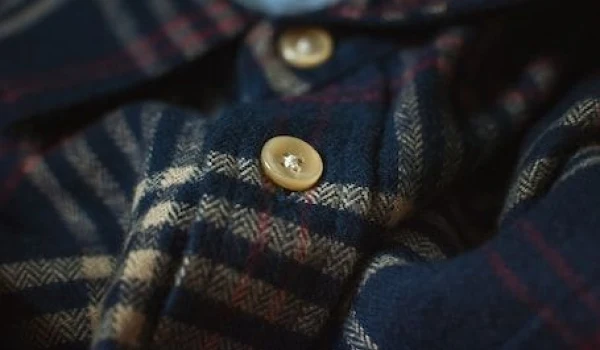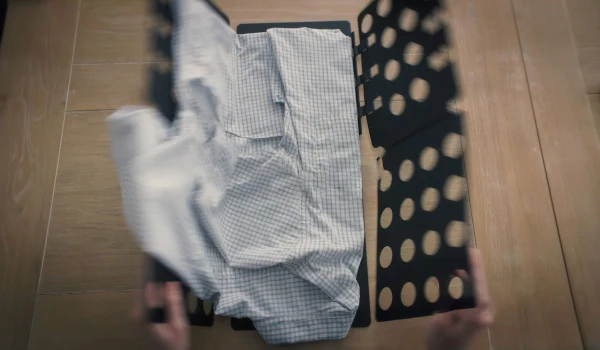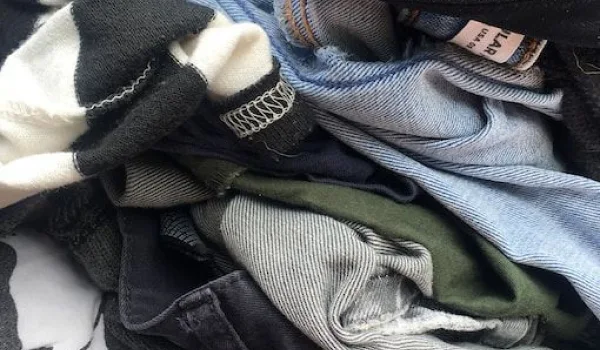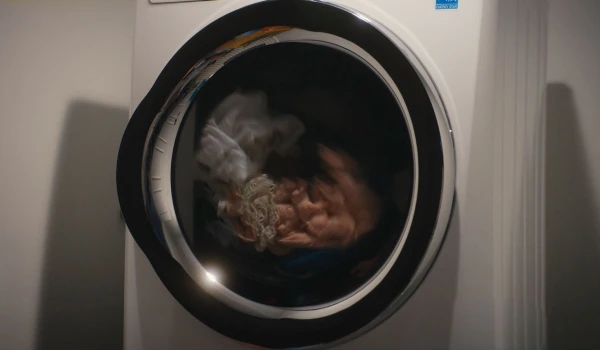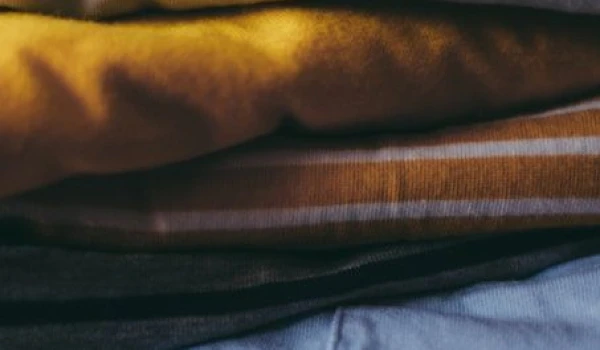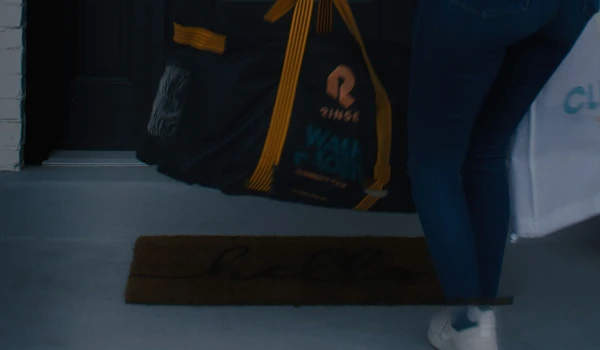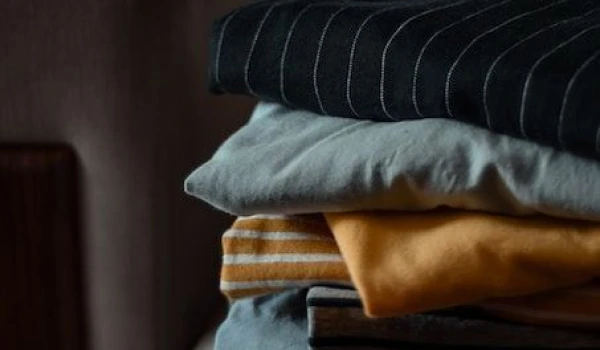Care
Clothing care tips to make your wardrobe last

Introduction
Soft, luxurious, and high maintenance – these are the first few of the things that come to mind when people think of cashmere. While this delicate fabric does require a bit of attention, don’t let that stop you from upgrading your wardrobe with a few cozy cashmere pieces. If you clean, dry, and store your cashmere properly, it’s easy to keep it in excellent shape.
Take a deep breath and let us guide you through the process – it’ll be pain-free, we promise.
Can You Wash Cashmere? How?
Hand Wash
Yes, it’s possible to clean your cashmere at home. Whether you’re washing a sweater, dress, or scarf by hand, these steps will help you keep your cashmere fresh.
-
Fill your basin with cold water, and add a mild detergent such as Woolite, baby shampoo, or dish soap.
-
Let your cashmere soak in the basin for five minutes, before rinsing thoroughly.
-
Take out your clothing and fold it up into a ball to get the excess water out. Don’t wring your cashmere, which can stretch out the delicate material.
-
Place your clothing flat on a towel, and roll it up to remove any remaining water.
-
Lay your clothing on a drying rack. If you don’t own a drying rack, place it between two towels to dry.
Machine Wash
Don’t have the time to wash by hand? This might surprise you, but you can use a washing machine to clean cashmere. Put the garment in a laundry or mesh bag before you place it in the machine, and select the gentle cycle on cold water.
Professional Services
If you’d rather have a professional do the job, dry cleaning is always a good option for your cashmere.
At Rinse, our Dry Cleaning and Wash & Fold services are conveniently available 7 days a week. Visit our homepage to create your free account and schedule your first pickup. We have decades of experience cleaning cashmere!
Care tip: Ideally, you should clean cashmere after wearing it two to three times. In between washings you can remove any fabric pills with a cashmere comb or bristled garment brush. Pills don’t mean the cashmere you purchased is cheap – they’re simply a sign of friction from wear.
Introduction
Soft, luxurious, and high maintenance – these are the first few of the things that come to mind when people think of cashmere. While this delicate fabric does require a bit of attention, don’t let that stop you from upgrading your wardrobe with a few cozy cashmere pieces. If you clean, dry, and store your cashmere properly, it’s easy to keep it in excellent shape.
Take a deep breath and let us guide you through the process – it’ll be pain-free, we promise.
Can You Wash Cashmere? How?
Hand Wash
Yes, it’s possible to clean your cashmere at home. Whether you’re washing a sweater, dress, or scarf by hand, these steps will help you keep your cashmere fresh.
-
Fill your basin with cold water, and add a mild detergent such as Woolite, baby shampoo, or dish soap.
-
Let your cashmere soak in the basin for five minutes, before rinsing thoroughly.
-
Take out your clothing and fold it up into a ball to get the excess water out. Don’t wring your cashmere, which can stretch out the delicate material.
-
Place your clothing flat on a towel, and roll it up to remove any remaining water.
-
Lay your clothing on a drying rack. If you don’t own a drying rack, place it between two towels to dry.
Machine Wash
Don’t have the time to wash by hand? This might surprise you, but you can use a washing machine to clean cashmere. Put the garment in a laundry or mesh bag before you place it in the machine, and select the gentle cycle on cold water.
Professional Services
If you’d rather have a professional do the job, dry cleaning is always a good option for your cashmere.
At Rinse, our Dry Cleaning and Wash & Fold services are conveniently available 7 days a week. Visit our homepage to create your free account and schedule your first pickup. We have decades of experience cleaning cashmere!
Care tip: Ideally, you should clean cashmere after wearing it two to three times. In between washings you can remove any fabric pills with a cashmere comb or bristled garment brush. Pills don’t mean the cashmere you purchased is cheap – they’re simply a sign of friction from wear.

Stain Removal: Food, Drinks, and Cosmetics
No matter how careful you try to be, you might end up with a small stain on your sweater. Your initial urge might be to panic, but you can keep your cool – and your cashmere – by following our handy stain removal advice.
- Makeup or grease-based: First blot the stain. Then, pre-treat by soaking the cashmere in mild shampoo.
- Chocolate: Dip a cloth in liquid detergent and lightly rub the stained area, taking care not to scrub too hard.
- Red wine, tea, or coffee: Gently rub the stain with a cloth dipped in a mix of cold water and dish-washing liquid. Avoid soap or machine detergents, which can set red wine stains rather than remove them.
Afterward, rinse your garment in cold water and let it dry on a rack. Your cashmere should be as good as new!
How to Dry And Iron Cashmere
As previously mentioned, the best way to dry your favorite cashmere is to place it flat on a rack for about 24 hours. Towels can be used to soak up any additional water but are not required.
Make sure you do not put cashmere in the dryer nor place it on a clothesline – this may cause pilling or the fabric to stretch and become distorted.
When it comes to ironing, your best option is to steam with an iron or steamer. Ironing traditionally may flatten the yarns and cause the shape to become altered. Simply bring the iron over the garment without pressing down and you will notice the steam alone will take care of the creases!

Wash at the End of the Winter Season
Remember to make sure your cashmere is washed before you store it for the offseason. Moths are attracted to human scents, so you’ll want to get rid of any perfume or food odors before storage. As an added precaution, place some cedar wood moth repellents with your cashmere.
Storage: Long-lasting Care
To keep your cashmere looking its best, keep these tips in mind.
-
Don’t hang your cashmere sweaters or dresses. A hanger will distort the shoulders, and the garment will lose its original shape.
-
Instead, fold your cashmere and keep it in a drawer or on a shelf away from moisture.
-
When you’re putting your cashmere away for the season, place it in a breathable garment bag or storage box in a cool, dry area. To prevent wrinkles, you can wrap each piece of cashmere clothing in acid-free tissue paper.
Now that you’re fully equipped to care for cashmere, go ahead and stock up on this comfy and luxurious fabric in time for sweater season. You’ll look good and feel good!

Rinse – Your Cashmere Care Solution
If you don't have time or don't want to risk damaging your favorite cashmere, consider using a laundry and dry cleaner service such as Rinse. Our expertise in handling this material will ensure your clothes are cleaned with the highest care.
We offer pickup and delivery services for all your laundry and dry cleaning needs, any day of the week – you do not even need to be home. Rinse users claim that we save them three hours per laundry load, time you can use elsewhere instead of worrying about washing your clothes!
Contact us at Rinse today to see our skill in action.

Have laundry or dry cleaning to do?
Rinse picks up, cleans and delivers 7 days a week. Amazingly awesome. Ridiculously simple.

Introduction
Whether your closet looks like you were just visited by Marie Kondo or a Dothraki Horde, we could all do with a couple home organization tips to keep our closet manageable and our clothes in optimal condition.
It’s okay, these organization tips will still be helpful long after the references above ;)
So read on! It’s time to clean up your closet and create a polished and personalized space that you can enjoy each time you get dressed.
Why Is Clothing Organization Important?
Sure, you might have a system you currently use or you "just know" where everything is, but what if there was a way to enhance your clothes storage organization game? Not only can it be more visually pleasing, but storing and hanging clothes can become a source of pride.
Here are some of the main benefits of utilizing efficient clothing storage techniques:
-
Efficient use of space: Make the most out of your storage space. Find additional capacity if you have limited spacing, or clear out clutter if you have abundant closet space.
-
Time savings: Your clothes will be accessible and easy to find. Avoid stress and spending time looking for your favorite sweater in the morning as you rush to get ready for your day.
-
Ideal outfit variety: You will naturally wear more of your clothes if you can see them. It is easy to forget about some garments that are out of sight.
-
Seasonal rotation: A well-organized wardrobe changes with the weather. Storing off-season garments separately, such as in cardboard boxes, storage containers, or vacuum-sealed bags is a great way to keep your space efficient.

7 Tips to Store Your Clothes Efficiently
Keep your daily essentials in the front row
You've heard the phrase "out of sight, out of mind" – while that usually applies to former flames, the same rule also works for closet organization.
Store your least-worn items at the back so you can dedicate prime closet real estate to your most beloved pieces. This will make getting dressed a lot more convenient, and you'll avoid the all-too-familiar situation of rummaging through the closet and ending up with a pile of discarded clothes on the floor or bed.
Style tip: Organize your go-to accessories, like a classic watch or simple jewelry, on a small tray next to your closet. Having them visible will encourage you to wear them and give you a more complete and polished look.
Think like a pro: know when to fold 'em
It might seem basic, but improper storage can cause a garment to lose its shape. Make sure you properly note which items to fold and which items to hang.
Clothes you should fold: Gently fold delicate items such as cashmere sweaters and heavy knits. For extra care, you can add a layer of acid-free tissue between garments.
Denim should also be folded, as hanging can cause it to stretch out in the wrong areas. Casual items such as T-shirts and tops can work both ways, based on personal preference.
Clothes you should hang: Keep your outerwear fresh by hanging them for storage. Your vintage leather jacket, silk blouse, or suit would appreciate the extra TLC.
Invest in some flocked hangers with velvet lining to keep your choice garments in mint condition. As always, any cocktail attire is best stored in a garment bag.
Out-of-season items don’t need prime real estate
Before putting anything in the closet at the end of each season, make sure your clothes are prepped for storage.
Launder items as needed, or send your clothes to a trusted dry cleaner for professional service – especially important for winter coats. This removes any scents or stains, as moths are attracted to undetectable smells.
Don't forget to clean your closet at least once per season (it can get dusty). It's also a good idea to go through and remove any items you don't wear regularly. Consider selling or donating the pieces that are in good condition – doing so will help keep your closet organized as well as help those in need.
Clean before storing
Spring may be on the way and you may no longer need your winter clothes, but make sure to wash or dry clean them before putting them away for the year. Remove dirt, stains, and odors so you have fresh garments ready for you next year.
Make labeling your best friend
There is no better feeling than finding what you're looking for right away when you're venturing into the basement, attic, or storage unit. To achieve this, organize your clothes by person, season, or type. Use labels on your plastic containers or wardrobe boxes and make storage a breeze.
The elements of style: invest in the right storage
The essentials: Storage bins are your best friend. Instead of unsightly plastic bins, consider linen storage organizers. Fabric organizers help your clothing stay fresh by allowing air to circulate. Try borrowing elements from Scandinavian decor, such as a set of wooden or copper hangers, to help your closet achieve a minimalist and uniform aesthetic.
The extras: Personalizing your space does not always require an involved process. Switching out little things can make a huge difference, such as adding some decorative items or art in or around your wardrobe. You can also paint or wallpaper the inside of your closet to inject a little more color and personal style.
Fill some sachets with dried lavender buds and place them in your closet to keep your clothes smelling great and repel any moths that might be creeping around your wardrobe – it's a pleasantly scented alternative to using mothballs.
Cedar chests are also a smart choice for woolens, as Red Cedar has natural oils that kill moth larvae (it's a good idea to first put the clothing in a resealable plastic bag for more protection).
The options: It may be useful to consider the pros and cons of different storage unit options:
Cardboard Boxes
-
Pros: Cheap, recyclable, and great for short-term storage
-
Cons: Prone to mold growth, absorbs smells and liquids, a magnet for bugs
Plastic Bags
-
Pros: Affordable, easy to transport
-
Cons: Prone to mildew growth via moisture accumulation, not great for long-term storage, disposal not environmentally friendly
Vacuum Bags
-
Pros: Great for seasonal clothing storage as bags become compact and save space
-
Cons: Prolonged compaction can damage clothing fibers, reducing its long-term effectiveness
Cotton Garment Bags
-
Pros: Breathable (preventing mold and mildew growth), great for long-term storage, keep dust out
-
Cons: Not very compact, not transparent (need labels!), more expensive
Plastic Storage Container
-
Pros: Sealable (no dust or bugs), easy to stack, good long-term solution that keeps your clothes protected
-
Cons: Can be expensive, can warp or crack, retains odors, not biodegradable or the most sustainable option
Be aware of moisture and climate conditions
Make sure the clothes are fully dry before storing them. Any residual dampness will result in mold or mildew growth – a terrible surprise the next time you look for these clothes.
In addition, consider the temperature of where you'll be storing your items. You do not need to invest in a climate-controlled storage unit but try to avoid keeping clothes in self-storage places, such as a garage. Humidity and temperature changes can damage the fibers – the best storage temperature is one that humans would enjoy too.

Here's What You're Doing Wrong in Terms of Storage
Here are a few common errors we see when it comes to clothing storage:
-
Using the wrong hangers: Hangers come in a wide range of sizes and materials. Too small and they cause wrinkles, too large and they form shoulder bubbles on your clothes. Ideally, use lightweight, non-slip felt hangers for delicates and wooden hangers for outerwear. Skip metal hangers.
-
Folding lingerie: There's a reason why they are called delicates. Do not fold bras and avoid storing other clothes on top of them to keep their shape and elasticity.
-
Stacking shirts instead of filing: Organizing experts state that clothes should not be stacked. Instead, they should be folded and stored vertically in rows, like a filing cabinet. This way, you can always see what is in your drawers and effectively use precious storage real estate.
-
Overstuffing containers and drawers: Not only is it hard to open and close these storage units, but this practice damages fabrics and makes it hard to find what you're looking for. Invest in other storage ideas (such as seasonal rotation) or consider reducing the amount of clothing you own.

Clean with Rinse Before Storing
While closet maintenance might seem like a chore, keeping these tips in mind will help you streamline the process and stay organized. One last tip is to consider using a professional laundry and dry cleaning service, such as Rinse, to clean your clothes before storing them.
We are experts in cleaning all types of garments and fabrics, ensuring that your clothes come back in pristine condition. We offer pickup and delivery, 7 days a week, and will handle washing, drying, folding, and ironing. Save time and effort by choosing Rinse for your clothes care before storing.
Contact us at Rinse today to see our skill in action.

Have laundry or dry cleaning to do?
Rinse picks up, cleans and delivers 7 days a week. Amazingly awesome. Ridiculously simple.

Introduction
When you launder clothes, an important consideration is the water temperature. Should you use hot water? When is cold water the better choice?
The answer depends on the type of stain and the fabric. We've all been in situations where we rub a stain until our arm falls off, and yet, the stain persists. The problem could be rectified with the right water temperature.
Luckily, we're here to solve your stain removal woes. Let's look at when to use hot or cold water for stains.
Why Does Hot Or Cold Water Matter For Stain Removal?
Both hot and cold water are important for washing clothes. However, certain factors make one more effective than the other for stain removal.
Hot water removes stains by breaking down and dissolving the stain-causing substances. Cold water has a different mechanism – it prevents the binding between proteins from the stain and the fabric, making it better for protein-based stains like baby food or blood.
In general, if you use the wrong temperature to remove a stain, you will find the results disappointing and need to rewash your clothes. This is not just a waste of time and energy, but also wear on the fabric's texture and color.
In general, hot water is better for synthetic fabrics, while cold water is better for natural fabrics.
However, in some cases, you can use both hot water and cold water. Such instances include stains from fruit juice, urine, vomit, or tomato sauce.

When to Use Cold Water
Cold water, in combination with laundry detergent, makes an effective stain remover. Cold water is ideal when washing delicates as it is gentler on the fabric and helps protect it. A delicate garment has a higher risk of shrinking, fading, or losing its shape when exposed to hot water.
Cold water is also more eco-friendly since it uses less energy compared to hot water, reducing your carbon footprint.
Here are some stains you can remove with cold water:
-
Grass stains
-
Fabric
-
Juice and milk
-
Baby food
-
Blood
-
Water-based paint
-
Egg
One thing you'll notice about these stain types is that most of them are protein-based. Let's take a blood stain as an example. It contains proteins that will coagulate in hot water, making it harder to remove the stain.
Note that sometimes removing a blood stain may require some extra effort, and cold water alone may not suffice. Here's what to do in that scenario:
-
Make a solution of two parts water and one part vinegar.
-
Soak the blood-stained area for 30 minutes.
-
Blot or rinse the stain with a damp cloth. Do not scrub the stain, as this may spread the blood further.
-
If the stain persists, mix a tablespoon of laundry detergent with a cup of water and apply it to the stain. Let it sit for 15 minutes before blotting or rinsing with a damp cloth.
However, keep in mind that repeated application of undiluted vinegar can break down the fabric's fibers – use white vinegar sparingly on clothes.

When to Use Hot Water
You should use hot water if you're dealing with oily or greasy stains. These include butter, cooking oil, and sweat. Here are some additional stains you can remove with hot water:
-
Makeup
-
Wine
-
Lotions
-
Gum
-
Grease
Pretreatment and presoaking can often help in getting rid of stains easily. For example, if you're dealing with a sweat stain, pretreat it by soaking the stained garment in a mixture of half a cup of white vinegar (distilled) and a cup of hot water.
Take it out after 30 minutes and put it in the washing machine on a hot cycle.

When to Use Cold or Hot Water
As we've already mentioned, you can wash certain clothes and remove stains with any water temperature.
In these cases, most people prefer defaulting to cold water since it's less harsh on clothes and saves energy and money. Here are some stains that you can deal with using either hot or cold water:
-
Tomato sauce stains
-
Mud
-
Fruit stains
-
Chocolate
-
Coffee
If the stain doesn't go away, you may have to rewash it. Just give the stain a good rub before you throw it in the washing machine again.

How to Remove Oil-Based Stains
Here's what you need to know about oil-based stains: you can't remove them with hot or cold water or even a combination of them. That's because water and oil don't mix.
Most other types of stains are either protein-based or dye-based. Both protein and dye can dissolve in water. However, the same is not true for oil.
Therefore, you will need additional solutions to get rid of these stains, specifically substances with carbon ends that attach to the oil molecules and pull them away from the fabric.
Here are some solutions you can use for oil-based stains:
Oxygen Bleach
It's time to bring the big guns out when you have to tackle tough stains, such as motor oil ones.
Oxygen bleach will do the job because it is composed of hydrogen peroxide and sodium carbonate. Upon water exposure, the bleach releases oxygen, which lifts the oil from the fabric's surface.
Here's how to use it:
-
Create a mixture of oxygen bleach with water. The packaging will come with instructions.
-
Soak the stained fabric in the mixture for an hour or overnight, depending on how severe the stain is.
-
Rinse the garment.
-
Wash it in your regular washing machine cycle.
Only do this with bleach-safe clothes. Otherwise, the colors will fade, and the fabric could get damaged.
Dishwashing Soap
Dish soap is made to cut through grease on dishes. So, it must do the same on clothes, shouldn't it?
-
Apply a generous amount of dishwashing soap to the stain.
-
Rub it in with your fingers.
-
Let the soap sit on the stain for 10 to 15 minutes.
-
Rinse the dishwashing soap off with warm water.
-
Wash and dry the fabric as you normally would.
Make sure you've removed the soap from the fabric completely before you throw it in the washing machine with the rest of your laundry.
Solvent-Based Cleaners
There's no better stain remover than a solvent-based cleaner when it comes to oily stains.
-
Read the instructions on your solvent-based cleaner.
-
Apply it to the stained area according to those instructions.
-
Let the solvent sit on the fabric for a few minutes, but don't let it dry.
-
Rinse off the solvent with warm water.
-
Run a regular wash cycle on the fabric.
Regardless of the solvent-based cleaner you use, it's imperative to check the fabric's label for any special care instructions.

Experience Effortless Stain Removal with Rinse
Some stains are just too stubborn and don't want to leave your clothes, irrespective of the type of cleaner you use. But don't lose hope, there's a solution for that too!
Rinse's professional laundry service will take the load (quite literally) off your hands. Since we have multiple years of expertise in tackling tough to downright impossible stains, trust us when we say that we know how to do the job right.
For your convenience, we pick up laundry and dry cleaning from your doorstep and deliver it back. You simply have to schedule a pickup, and voila!
Contact us at Rinse today to see our skill in action.

Have laundry or dry cleaning to do?
Rinse picks up, cleans and delivers 7 days a week. Amazingly awesome. Ridiculously simple.

Introduction
There's no denying that a commercial laundry detergent is more convenient and readily available, but you also have to account for its environmental impact and cost.
On the other hand, baking soda and white vinegar are everyday household items you can simply pull out from your pantry and add to the washer. Why add vinegar to laundry, though? For one, it removes stains effectively. Second, it removes odor, mold, and mildew.
What about baking soda? It's a deodorizer, which means it absorbs and neutralizes unpleasant smells. Knowing this, it is unsurprising that combining baking soda and vinegar creates an effective laundry solution.
How to Use Baking Soda in Laundry
Baking soda is a staple that you can use for anything from cooking to cleaning. You can even use it to clean kitchen grease and scum in bathroom drains.
Let's stick to laundry for now. Here are some reasons to add baking soda to your front loader.
-
Softening Fabrics: We know a fabric softener freshens and softens clothes. But what about the chemicals? They can irritate your skin and harm marine life. Baking soda is a much gentler alternative. It increases the pH of water and helps your clothes rinse better. All you need to do is add half a cup to your load.
-
Removing Odors: If your carpets undergo a pet accident or a nasty spill, most experts would advise you to use baking soda to get rid of the stain. The same applies to other smelly fabrics, too. Baking soda helps remove odors like those from perspiration and smoke, leaving your clothes smelling fresh. Fill a bucket with hot water and add a cup of baking soda to it. Soak your clothes overnight in this mixture. Run a regular laundry cycle the next day.
-
Complementing Bleach: If you want crisp and clean whites, chlorine bleach is the way to go. We've got another pro tip: add a cup of baking soda to the mix. It will improve the bleach's efficiency and potency.
-
Deodorize Towels: Have you ever noticed a stale smell in your towels? Baking soda can fix this issue. Add 3 to 4 tablespoons of baking soda to a sink full of water. Soak your towels for at least 20 minutes, and then wash as usual.

How to Use Vinegar in Laundry
When it comes to laundry hacks, you'll see distilled white vinegar in pretty much every list, and rightfully so. If you're looking for the right formulation, most experts would recommend one with 5% acidity. Here's how you can add vinegar to laundry.
-
Odor Removal: Sometimes, your fresh laundry doesn't smell too fresh. You might have to rewash those clothes. One way to avoid this situation is to add half a cup of vinegar to the load you want to freshen up.
-
Stain Removal: You can remove tough stains by applying vinegar to them directly. Mix a tablespoon of laundry detergent and a tablespoon of vinegar, and apply the mixture to the stain. Let it sit for about 30 minutes before washing as usual. Use this for sweat stains, and thank us later.
-
Color Restoring: If your clothes seem to be losing their vibrant colors, try adding a quarter cup of vinegar to your laundry. It can help restore the brightness and make them look new again.
-
Fabric Softening: Like baking soda, vinegar is also a handy alternative to commercial fabric softeners. Add a quarter to half a cup of distilled white vinegar in the final rinse. Your clothes will come out feeling soft and fluffy.
-
Washing Machine Clean: A clean washing machine is mandatory for fresh laundry. But most people overlook this step. All you have to do is run a hot cycle with two cups of vinegar in the washing machine. Viola! A cleaning washing machine that doesn't make your clothes smell funky.
Using Vinegar and Baking Soda Together
Sometimes, you need to double the cleaning power to tackle stubborn stains. Baking soda and vinegar work quite well together, so this shouldn't be a problem. Here's how to do it.
-
Pre-treat your clothes with a stain remover of your choice.
-
Add the load to the washing machine.
-
Put a cup of baking soda into the washer's drum.
-
Add the laundry detergent in its respective compartment.
-
Pour half a cup of vinegar into the fabric softener compartment. If you have a front loader, it would most likely have the mechanism by which liquids are released in the drum based on the cycle.
-
Alternatively, add vinegar later in the rinse cycle.
-
Start the washing machine and let it run as usual.

Vinegar and Baking Soda Risks
Sure enough, both baking soda and vinegar can work in tandem with your sustainable laundry routine. However, you have to realize that even these natural products come with their risks.
Risks of Vinegar for Laundry
We must first remember that vinegar has a low pH (2 to 3), making it very acidic. Acids don't react well with some materials. For example, vinegar can damage rubber and metal parts, such as the rubber gasket, in your washing machine over time. It may lead to rusting and cracking, sometimes beyond repair.
In addition, the acidity can weaken certain fibers in rayon, nylon, linen, and cotton clothes. Some clothes also use pH-sensitive dyes, which may bleed if vinegar is used.
Earlier, we said you should add vinegar in a separate compartment rather than add it with the detergent. That's because some detergents are alkaline. When you add baking soda or vinegar to an alkaline detergent, they can neutralize each other. As a result, the cleaning efficiency decreases.
Another thing you need to keep in mind is the efficacy of the vinegar brand. Most store-bought vinegars are water-based. That means you will have to use more of it to get the job done. If you want to use vinegar regularly, you better buy it in bulk or go for a cleaning vinegar that has greater acidity.
Risks of Baking Soda for Laundry
Unlike vinegar, baking soda is alkaline, and its chemical name is sodium bicarbonate. It has a high pH of 9. At such high alkalinity, certain fibers like cashmere, silk, and wool lose their color. Similarly, all protein-based fibers are sensitive to alkaline substances.
Like white vinegar, baking soda can fade clothes with pH-sensitive dyes. It's best to check the manufacturer's instructions before using it on your clothes.
If your house gets hard water, baking soda can leave a residue on clothes. The minerals in hard water react with baking soda to form a white residue. Besides depositing on your clothes, the residue may also clog the washing machine filter.
A combination of hard water and baking soda is also detrimental to elastane and nylon fibers. The added stress can break down the fibers, making them less elastic over time.
Moreover, baking soda's effectiveness is questionable when it comes to heavily soiled clothes. It may not be able to remove tough stains like grease and oil without the help of a detergent.
Speaking of a detergent, don't use it alongside baking soda, as the latter can reduce the former's efficiency in cleaning low-pH-sensitive stains, such as wine, tea, and coffee.

Try Rinse
After reading the risks we mentioned above, you must be wondering, "What should I use then?". Well, we have just the solution for you — Rinse.
As a professional laundry and dry cleaning service, Rinse specializes in fabrics and everything associated with their care. Whether it's okay to use a certain natural cleaner or which fabrics should be washed separately, we know it all.
We deal with even the toughest stains, restoring your favorite clothes to their former glory. Our team understands the nuances of fabric care and uses the right techniques and products for your laundry.
Ready for the best part? We pick up and deliver clothes from and to your doorstep.
Contact us at Rinse today to see our skill in action.

Have laundry or dry cleaning to do?
Rinse picks up, cleans and delivers 7 days a week. Amazingly awesome. Ridiculously simple.
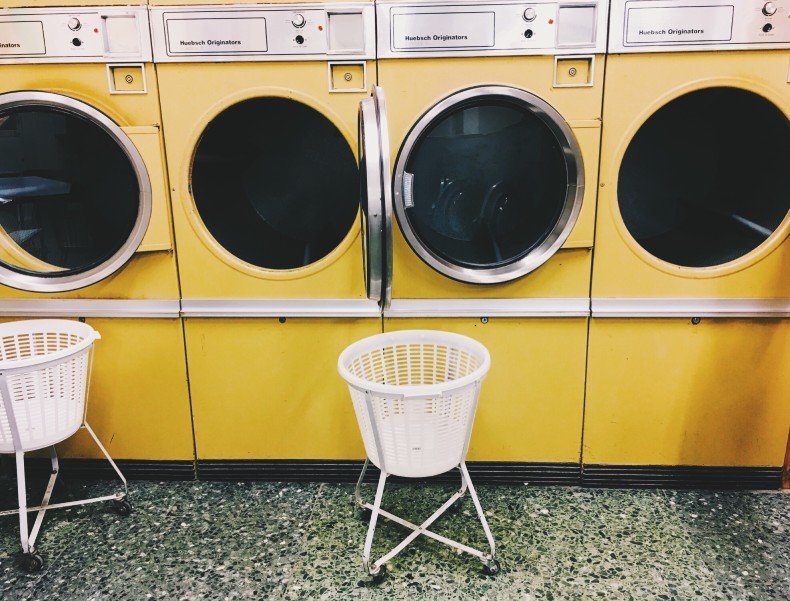
This article aims to provide readers with an understanding of fabric softeners, how they work, their potential downsides, and alternative, eco-friendly options.
What Is Fabric Softener and How Does It Work?
A fabric softener is a liquid or dry product that you add to your laundry to make it feel softer, smell nicer, and reduce static cling. Traditional fabric softeners do this by coating the fabric with a layer of chemicals that smooth down the fibers. The lubrication also reduces friction and makes clothes feel softer.
A fabric conditioner is also often added in the rinse cycle of a wash. It helps combat the fading and piling of garments. Plus, it adds some shine to your clothes and prevents stretching.
Here's how to use a fabric softener:
- Add laundry detergent and let it dissolve for a minute.
-
Add your clothes and start the wash cycle.
-
When you reach the rinse cycle, add fabric softener to the dispenser or dilute it with water and add it to the washing machine tub.
Note that some washers have a fabric softener dispenser. If this is the case, you can fill it when you are adding your detergent in step 1.
If you use a wool dryer ball or dryer sheets, put a new dryer sheet on and run a dry cycle. Or you can add 2 to 3 dryer balls in the dryer.
Are There Any Cons of Using Fabric Softener?
Yes, there are quite a few cons of using fabric softener. You should be familiar with them before you add a fabric softener to your grocery list.
First, do not use fabric softeners for moisture-wicking fabrics, such as sportswear and towels. Fabric softeners break down the fibers in these fabrics and leave a waxy buildup that makes the material less absorbent. They can also reduce a garment's breathability by clogging the pores in the fabric.
A fabric softener may also be an irritant for sensitive skin. It can cause contact dermatitis, which is an itchy red rash that appears on the skin where a fabric softener has been in contact. If you have sensitive skin, it's best to use a scent-free formula.
Some experts also note that fabric softeners affect your clothes' texture with extended use. They tend to make clothes more "flat" and less fluffy over time.
Besides damaging your clothes, glutaraldehyde in fabric softeners may cause skin irritation and respiratory problems. Another common ingredient in fabric softeners is hexylene glycol, which is associated with skin, respiratory, and eye irritation. They also contain quaternary ammonium compounds that trigger asthma and could harm the reproductive system if the following are listed on the label:
-
Distearyldimonium chloride
-
Compounds ending in "ammonium chloride"
-
Biodegradable fabric softening agent
-
Cationic surfactant
Fabric softeners also harm the environment since they're usually made from petroleum products, in addition to containing synthetic musks like galaxolide, which is extremely toxic to aquatic life.

6 Natural Fabric Softener Alternatives
Since chemical fabric softeners pose multiple risks but the desire for soft clothes remains, many people are switching to natural fabric softener alternatives. These alternatives use natural ingredients, making them eco-friendly. Some of them are also plant-based, while others are organic. Here are some options:
Vinegar
If you don't want to run to the store to get ingredients for a DIY fabric softener, you can just head over to the kitchen and take out the bottle of distilled white vinegar. It's not only non-toxic but also inexpensive.
Here's how to use it:
-
Put half a cup of white vinegar in the fabric softener compartment or during the rinse cycle.
-
Alternatively, you can wait until drying time and add vinegar to your wool dryer ball.
Note vinegar may add an unpleasant smell to your laundry. However, once the clothes dry, the smell goes away.
Baking Soda
Of the unscented alternatives to fabric softener, baking soda stands out. It's also a deodorizer, which means it will help eliminate any unpleasant smells in your laundry.
Simply put a cup of baking soda in the washer during the rinse cycle. Alternatively, you can add baking soda when you start the regular cycle. Both ways work fine.

Essential Oils
Essential oils alone won't do the job – you'll need vinegar too. Here's how to make a non-toxic fabric softener with these two ingredients:
-
Take an empty bottle or container and clean it out thoroughly. Add 2 cups of white vinegar to the bottle.
-
Put 20-30 drops of an essential oil of your choice. Lavender, lemon, bergamot, and peppermint are great options.
-
Close the bottle.
-
Shake it well.
To get the best softening effect, put about a quarter cup of this mixture during the rinse cycle.
Hair Conditioner
Just a heads-up: this one is scented. But it's one of those products that you probably already have at home, so why not repurpose it?
-
Clean an empty bottle and fill it with a cup of hair conditioner.
-
Dilute the hair conditioner with 3 to 4 cups of distilled water.
-
Shake well to mix both ingredients.
-
Add half a cup of this solution to the rinse cycle.
Hair conditioner will not only make your clothes smell good, but it will also make them softer and more comfortable to wear.
Wool Dryer Balls
Wool dryer balls could be considered the most non-toxic fabric softener. They are suitable for towels too. Since they do not contain fragrance or chemical ingredients, they're perfect for people with sensitive skin.
It's pretty simple to use wool dryer balls:
-
Toss three balls in the dryer with your laundry.
-
Dry on a regular cycle.
Wool dryer balls will help reduce static and wrinkles while also making your clothes softer. Plus, they can be reused repeatedly, making them a more eco-friendly option.
Check wool dryer balls for reusability when you're out shopping for them. Some can be used for up to 1,000 loads – farewell, single-use dryer sheets.
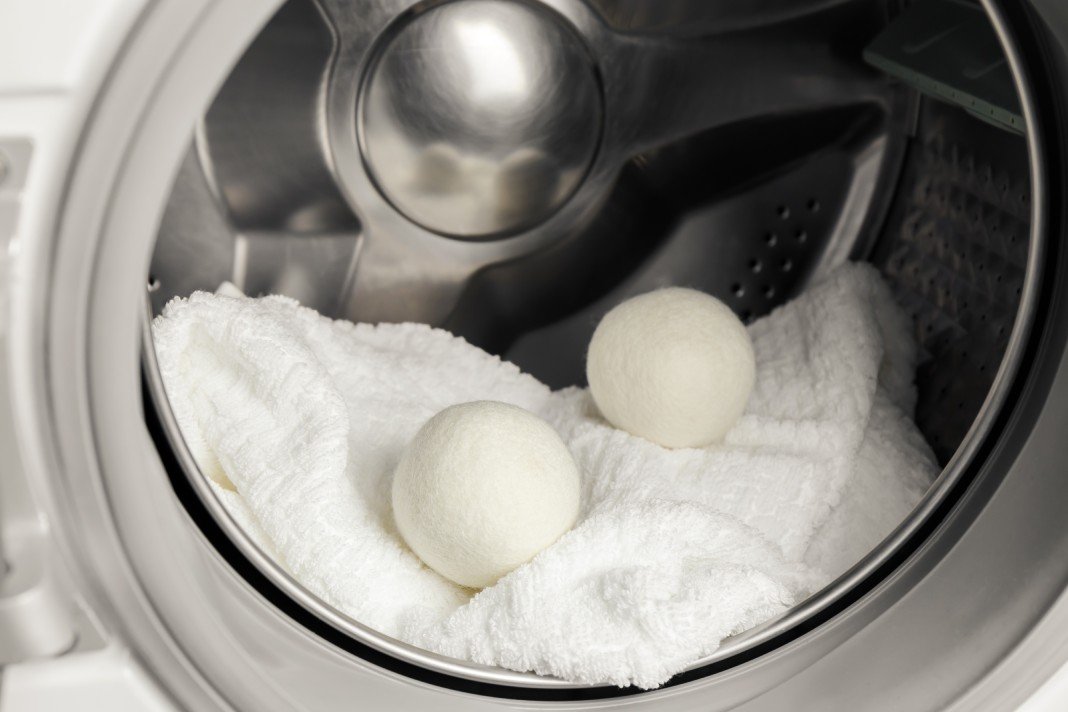
Vegetable Glycerin
Vegetable glycerin isn't just for homemade soap-making or your skincare routine anymore. It's also a great natural fabric softener. Here's how to use it:
-
Add half a cup of vegetable glycerin to a gallon of water.
-
Add a few drops of your favorite essential oil.
-
Put half a cup of this solution into the washing machine during the rinse cycle. Or, you can put it in the fabric softener dispenser in your washer.
The US Food and Drug Administration considers vegetable glycerin as GRAS (generally recognized as safe). You can rest easy knowing it won't harm your skin or clothes. Since it's also water soluble, it won't leave any residue on your laundry, and it washes off easily.
A Better Eco-Friendly Laundry Care Solution
We're living in a time where sustainable practices have become the need of the hour. If we want to preserve the environment for future generations, it's important to make small changes in our daily routines.
One of these changes can be using eco-friendly laundry care solutions. As a professional laundry and dry cleaning service, Rinse is committed to using non-toxic and eco-friendly products. At Rinse, we only work with dry cleaning partners with environment-friendly and perchloroethylene-free (a carcinogen) methods.
We also use high-efficiency washing machines that consume less water than the washer at your home. As a result, we save millions of gallons of water each year.
Schedule your first laundry pickup today and experience the difference in using an eco-friendly laundry service.
Image Source: Environmental Working Group

This article will analyze how much time dry cleaning takes depending on garment types and detail the dry cleaning process.
What Is Dry Cleaning?
While your washing machine might work wonders for your everyday laundry, dry cleaning occupies a special niche for clothing requiring delicate handling and attention. Unlike traditional laundering methods, dry cleaning relies on a chemical solvent, often perchloroethylene (or perc), to clean garments without water. This process is particularly suitable for fabrics that can't withstand the rigors of a washing machine and dryer, such as silk, suede, wool, and delicate clothing items.
The dry cleaning process involves placing garments in a machine, where they are gently agitated in the solvent, helping to remove dirt and stains. After the cleaning cycle, the solvent is drained and distilled for reuse, while the cleaned garments are dried and meticulously inspected for any remaining stains or imperfections.
But how long does this specialized cleaning method take, you ask? A dry clean's duration can vary depending on several factors, including the type of garment, the severity of stains, and the workload at the dry cleaners. In the following sections, we'll dive deeper into the intricacies of dry cleaning time, shedding light on what you can expect when you entrust your garments to professionals.

How Much Time Does Dry Cleaning Take?
After dropping off your clothes with a professional dry cleaner, it's only natural to wonder how long it will be before they're ready for you to wear again. As mentioned above, the dry cleaning time can vary depending on the type of clothing and the processes involved. Here's a breakdown of typical dry cleaning turnaround times for various clothing types:
1. Party Dresses: Those beautiful party dresses often feature delicate fabrics and intricate designs. Due to the need for special care, the dry cleaning time for them typically falls in the 3–5-day range.
2. Suits: Suits are a staple of formal attire and receive meticulous attention during dry cleaning. You can usually expect a turnaround time of 2 to 3 days for your suits.
3. Leather, Fur, and Suede: Garments made from these luxurious materials require specialized dry cleaning, extending the turnaround time to ~5 to 7 days.
4. Shirts: Everyday wear like shirts is generally quicker to process. The dry cleaning time for shirts is often 1 to 2 days.
5. Coats and Jackets: Heavier outerwear pieces, such as coats and jackets, may take longer due to their size and the thorough cleaning required. The average dry cleaning time for these items is 3 to 5 days.
It's important to remember that these timeframes are general estimates and can vary from one dry cleaner to another. Factors such as the cleaner's workload, the efficiency of their equipment, and the availability / demand of express services can all influence the dry cleaning turnaround time.
If you're in a hurry to have your garments cleaned, many dry cleaners offer rush services for an additional fee. This can significantly reduce the waiting time, ensuring your clothes are ready when needed.
While dry cleaning times may vary, the result should always be the same: professionally cleaned, stain-free garments that have been meticulously inspected and are ready to make you look your best.

How Is The Process Of Dry Cleaning?
The process of dry cleaning is meticulous and sophisticated, ensuring that your garments receive the best care without water. Here's a detailed breakdown of the steps involved:
1. Tagging
The journey of your garment through the dry cleaning process begins with tagging. Each piece is carefully tagged with a unique identifier, ensuring it remains identifiable throughout the process. This step is crucial to avoid any mix-ups and ensure a seamless experience.
2. Damage Review
Before the dry cleaning process begins, a thorough damage review is conducted. This involves inspecting the garment for stains, tears, or loose buttons. Any issues found are documented to ensure they are addressed appropriately during cleaning.
3. Spot Treatment
The next step involves spot treatment. Experienced dry cleaners use specialized spot-cleaning techniques to target and pre-treat stains and soiled areas on the garment. This is a crucial step to remove stains effectively during cleaning.
4. Cleaning Phase
Now, your garment enters the heart of the dry cleaning process. The primary cleaning agent used is perchloroethylene (commonly known as perc), which is a powerful solvent. The garment is immersed in this solvent, and a gentle but thorough cleaning cycle begins. During this phase, the solvent effectively dissolves and removes dirt, stains, and odors from the fabric.
5. Drying and Inspection
After the cleaning phase, your garment is carefully dried in specialized equipment designed to minimize shrinkage and protect delicate fabrics. Once dry, it undergoes a meticulous inspection. Dry cleaners scrutinize every inch of the garment, ensuring that stains are gone, buttons are secure, and the fabric is pristine.

A New Dry Clean Experience With Rinse
As we delve into the world of dry cleaning, it's essential to explore the process and the evolving landscape of convenience and efficiency. Here, we introduce you to a new and innovative way of experiencing dry cleaning – with Rinse.
At Rinse, we understand that time is a precious commodity, and the traditional dry cleaning process may not always align with your busy schedule. That's why we've reimagined the entire experience to offer you a more efficient and convenient solution.
Dry Cleaning Made Easy
Rinse brings the dry cleaning experience to your doorstep. Say goodbye to the hassle of physically going to a dry cleaner and waiting in line. With our service, you can schedule a pickup any day of the week, and our professional team will arrive to collect your clothes.
The Rinse Difference
Here's how Rinse streamlines the dry cleaning process:
-
Convenience: With Rinse, you can enjoy dry cleaning without leaving your home. Our team handles the entire process, from pickup to delivery, saving you valuable time.
-
Expert Care: Our experienced dry cleaning partners are well-versed in dry cleaning. They use the latest techniques and high-quality solvents to ensure your garments receive the best care.
-
Stain Removal: We understand the frustration of stubborn stains. That's why we pay special attention to stain removal. Our experts are skilled in identifying and treating different types of stains, ensuring your clothes look their best.
-
Fabric Care: Each garment is unique, and we treat it as such. Whether it's delicate silk, a cozy cashmere sweater, or a tailored dress shirt, we carefully handle your items to preserve their quality and integrity.
-
Environmentally friendly: Rinse is committed to sustainability. We use eco-friendly cleaning methods and solvents, minimizing our environmental impact. Your clothes come back fresh and clean without harming the planet. We do not use perc.
-
Transparent Pricing: No hidden fees or surprises. Rinse offers transparent pricing, so you know exactly what to expect.
Rinse transforms your dry cleaning experience into a hassle-free, time-saving solution. We prioritize your convenience, the quality of care for your garments, and our commitment to sustainability.
Contact us at Rinse today to see our skill in action.
Topics
Rinse Drop
We offer pickup and delivery if you can’t be present between 8pm and 10pm.
Our Valet will pick up or deliver your order to your doorstep or concierge, at which point you’ll receive a text with a photo showing where your items were left.
You can enable Rinse Drop on any (or all) of your orders.

